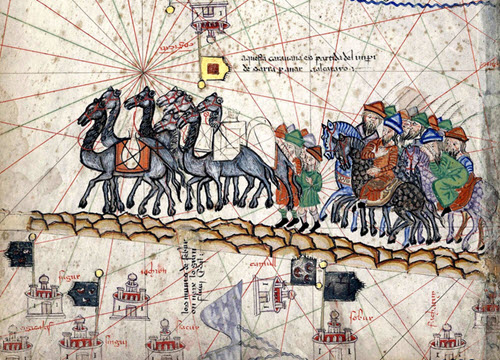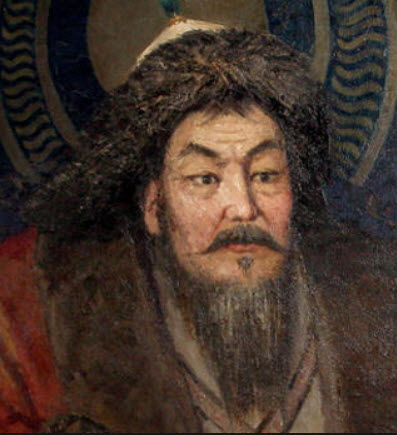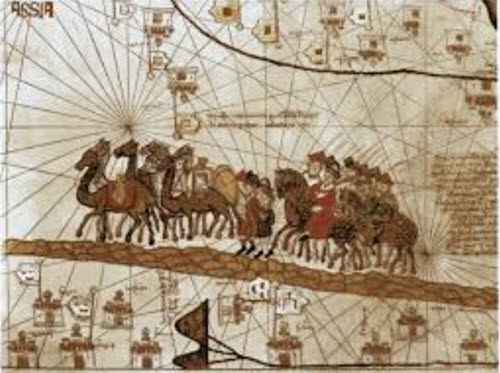What Is A Pax Mongolica
Pax Mongolia, which means Mongol Peace in Latin, is a historiographical term describing the stabilizing effects of the Mongol Empire in the vast Eurasian territory that the Mongols conquered in the 13th and 14th centuries Advertizing.

The Mongol Empire developed a reputation for fiercely guarding the Silk Road to ensure its usefulness for travelers. In gimmicky sources, it is non usual to find (probably a tad hyperbole) claims of how "a maiden carrying a asset of gold on her head could wander safely throughout the realm".
In a commercial handbook compiled around 1340, the Florentine merchant Pegolotti describes the state of affairs like this:
- "The road you travel from Tana [Azov] to Cathay is perfectly safe, whether by day or by night, co-ordinate to what the merchants say who take used information technology. Only if the merchant…should die upon the route, everything belonging to him will get the perquisite of the lord of the country in which he dies…And there is another danger: this is when the lord of the country dies, and before the new lord who is to have the lordship is proclaimed; during such intervals at that place have sometimes been irregularities practised on the Franks and other foreigners…"
Eventually, the Mongol Empire was divided into four khanates – Yuan dynasty, Golden Horde, Chagatai Khanate, and Ilkhanate – merely the Pax Mongolica remained until the disintegration of the khanates and the outbreak of the Black Plague in Asia; a illness which spread along the trade routes, including the Silk Road, and had far reaching social, economical and political effects for both Euroasia and northern Africa.
Genghis Khan and the promotion of the Silk Road

When Genghis Khan eventually rose to power and began his conquests, control of the Silk Route trade – and dealing with certain trade disputes – were an essential part of the development. One of the sources where this becomes apparent is the chronicle of Mongol history written by 'Ata-Malik Juvaini – himself non a Mongol – in the 1250s.
The flourishing of the Silk Route nether Mongolian rule was due to several factors, including Mongolian promotion of the route and the improvement of vital infrastructure that helped brand the trips safer.
Forced re-settling of craftsmen
The Mongolian khans were known to sometimes forcefully re-settling individuals forth the Silk Road equally they saw fit. The Franciscan monk Willem from Rubruck, who traveled on the Silk Road in the 1250s and visited the Mongol capital Karakorum, does for instance write virtually how he met a goldsmith named Guillaume Bouchier in the capital. Bouchier, a Paris native, had been kidnapped by Mongols at Belgrad and concluded upward in Karakorum. His wife, too French, had been kidnapped during the Mongol invasion of Hungary.
Another travel writer, the famous Marco Polo, describes settlements consisting of whole colonies of weavers from the Heart Eastward that had been forcefully moved to Mongolia and northern China by khans to satisfy Mongolian cravings for the blazon of luxurious Middle Eastern-style textiles that these weavers could produce.
Connection to Genoa
The European city-land Genoa benefited greatly from Pax Mongolica and from forming alliances with powerful Mongolian khans. The Genoese did for case sign a treaty with certain khans that gave Genoa exclusive privileges in the Black Sea ports, and coins were issued that bore the inscription of the khan on one side and the seal of the Banking company of St. George of Genoa on the other.
In the late 13th century, Genoan traders purchased a port city on the Black Body of water from the Gold Horde and established Kaffa, a flourishing trading settlement, there. Soon, they had more or less a monopoly on international trade in the Black Sea region and Kaffa became an administrative eye for other Genoese settlements that developed around the shores of the Black Sea. Kaffa also became home to a very large slave market. In 1204-1261, and then again in 1296-1307, Kaffa was nether the control of Genoa's arch rival, the Republic of Venice – another urban center-land on the Italian peninsula.
Muslim travel writer Ibn Battuta (b. 1304), who visited Kaffa while the metropolis was in Genoese hands, writes about Kaffa being a bang-up city and one of the world's almost celebrated ports, with a wonderful harbor in which Battuta personally saw roughly 200 vessels – both warships and trading vessels.
One of the reasons why the Golden Horde was and then interested in maintaining an alliance with Genoa was that information technology helped them with their connection to their allies in Arab republic of egypt, the Mamluks, since they could communicate with each other via Byzantinum.
Yam
Yam was a postal relay organisation adult by the Mongols. When a khan needed to quickly transmitt a message of long distances, he could transport it with a dispatcher who would deport a special bluecoat of authorisation called a paidze. The paidze gave its carrier the right to many forms of aid within Mongol territory, such as the correct to exchange tired riding animals for rested ones at the regularly placed relay stations.
Faith
In his writings, Marco Polo emphasizes the great Mongolian leader Kublai Khan's willingness to entertain "all the religions of the book" (i.eastward. Judaism, Christianity and Islam) while at the same fourth dimension practicing the rituals rooted in a traditional Mongolian religion. Kublai Khan also congenital a dandy observatory for himself, which he staffed with astrologers / astronomers of various origins, including Muslims from the Middle East.

Some Mongolian khans went through religious conversion, just the seem to have stayed clear of imposing conversion on their subjects. Their Russian subjects were for instance non forced to relinquish Christianity even when living under not-Christian khans, and the merchandise routes protected past the Mongols also helped Russian Christians to stay in touch with Christian centers located far to the west of Russia.
Russian federation under Mongol rule
Initially, the parts of Russia that were invaded and conquered by Mongols went through a period in the 1230s where the construction of masonry churches dropped sharply – something which historians take interpreted every bit a sign of bad times. Past the end of the 1200s, there was a revival, and in the 1300s we tin meet a real building blast during the reign of the Mongols of the Gold Horde.
Ane of the Russian cities that prospered under the Golden Horse was Novgorod, and the 14th century Advertizement was too very benign for Moscow which goes from being a rather insignificant town on the River Volga to existence a notable political and cultural center. During this era, the princes of Moscow had a very close and well-functioning relationship with the Mongol Khans.
Devastation of irrigation channels in Iran
One surface area that suffered greatly under Mongol rule and did not recover from its initial destruction during the conquest was a office of Iran that flourished prior to the conquest cheers to a circuitous hole-and-corner network of irrigation channels. The invading Mongols destroyed this network and it was not rebuilt again.
What Is A Pax Mongolica,
Source: http://www.silk-road.com/artl/paxmongolica.shtml/
Posted by: cannonbenty1991.blogspot.com


0 Response to "What Is A Pax Mongolica"
Post a Comment